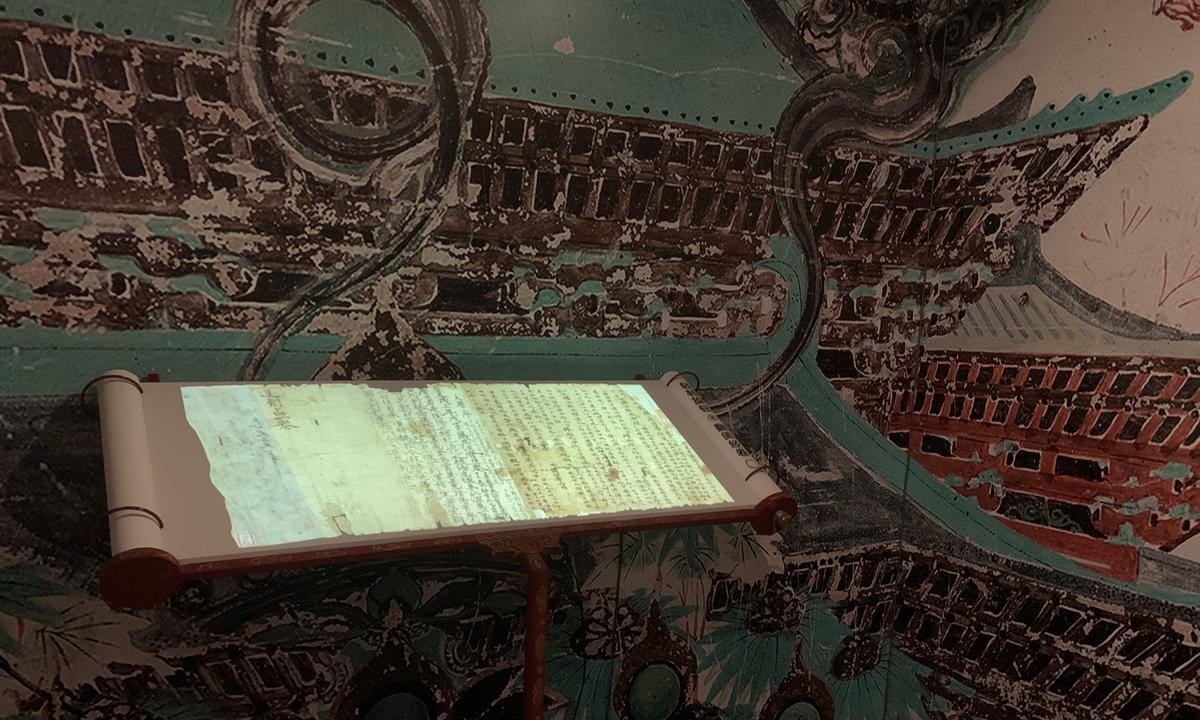
An ancient book of Dunhuang Literature found in the Mogao Grottoes in Dunhuang, Northwest China's Gansu Province. Photo: Courtesy of the National Library of China
Scattered around the globe, the world-renowned Dunhuang relics have been reunited for visitors to enjoy, as 80 replicas are displayed in Northwest China's Ningxia Hui Autonomous Region.
Held from Saturday to January 20, 2024, the relics from the exhibition have been restored through non-destructive 3D scanning, a technology that has been developed and used in recent years by many institutes to take their unmovable cultural relics on national or even world tours.
The exhibits inside the Guyuan Museum in Ningxia are replicas of Dunhuang originals preserved in multiple museums worldwide, including the British Museum. The replicas include various cultural relics such as silk paintings, paper and linen paintings, and scriptures from the Northern and Southern Dynasties (386-589), Sui (581-618) and Tang (618-907) dynasties, and Northern Song Dynasty (960-1127). They were all reproduced 1-1 with exactly the original color, according to the person in charge of the museum.
"[Those replicas] are like the modern version of Dunhuang cultural objects."
In 1900, the discovery of the Dunhuang Library Cave gave rise to Dunhuang art and culture. However, many treasures from the cave have been scattered abroad and to this day it has become extremely difficult to reunite them.
According to a Xinhua News Agency report, at least 40,000 cultural relics are scattered in more than 10 countries, including the UK and France. Over the past 100 years, Dunhuang scholars for generations have compiled and collected Dunhuang materials scattered overseas.
Chongqing-based cultural relic restorer Feng Bin told the Global Times that digitalization has always been vital to bring scattered materials home, especially for those taken from Dunhuang.
In 1994, the British Library launched the International Dunhuang Project (IDP), marking the first step in the digital sharing of Dunhuang cultural relics. In 2015, the National Library of France donated high-definition digital copies of Dunhuang documents to institutions such as the Dunhuang Academy.
"The exhibits of this time contain both very high research and appreciation values, as those materials are 'keys that open the history of that time.' Visitors are able to learn the splendid art and culture of Dunhuang at different times with different characteristics," said another staff from the museum.
The exhibition is jointly hosted by the Guyuan Museum in Ningxia and the Jiuquan Museum in Northwest China' Gansu Province.
Containing 735 caves full of Buddhist art, the Mogao Caves attract more than 1 million visitors every year to Dunhuang. To better aid research, scholars for years have been dedicated to using new technology such as 3D scanning and digital photography.
The Mogao Caves in Dunhuang are the subject of study of a national research institute called the Dunhuang Academy. As of 2022, the academy has completed digital photographing of 278 caves, image processing of 164 caves, 3D reconstruction of 145 painted sculptures, and the study of seven ruins. It has also created a panorama-tour software program that encompasses 162 caverns and over 50,000 digitized film negatives, including cultural artifacts from the caves.
Other institutions have likewise made similar attempts. Given the Yungang Grottoes' enormous significance in the history of human civilization, scholars' main concerns have been how to protect this archaeological find and make it known to the public.
The Yungang Grottoes Research Academy personnel see digitization as one potential remedy. After spending years in the caverns, the study team digitized the on-site relics, which enabled them to use 3D printing to replicate three grottoes so far.
"You can imagine the whole compound is a Lego model, with each Lego block more than two square meters in size. We used eight containers to put it together," Ning Bo, head of the 3D printing technology team at the Yungang Grottoes, told the Global Times.




